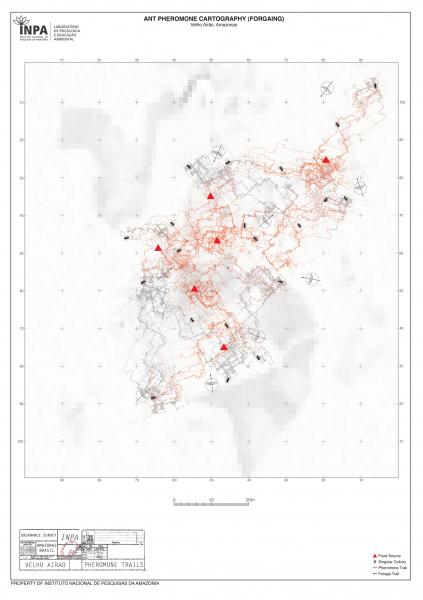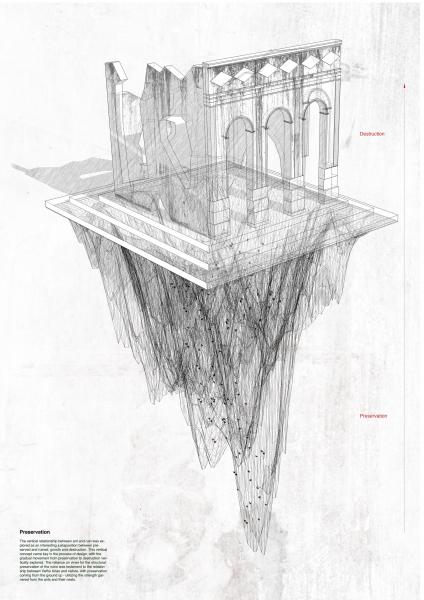Six hours and 30 minutes upriver from Manaus, the capital of the Brazilian state Amazonas, we reach our destination: a once-glamorous town, now abandoned and infested by fire ants. The only inhabitant is a Japanese man. Soap opera blasts from a TV in his hut as he explains how one should unfold a hammock to avoid the ants. At 10pm the power generator shuts off, leaving only darkness and the progressive myth of the Amazon – a populated forest connected by drones and long-distance technology that lives as a dream-resource reservoir for the dream of preservation itself.
In the morning our expedition into this technological environment continues. Moments of an Indian shaman wearing a sleeveless Panasonic t-shirt intertwine alongside tourist-friendly swimming with dolphins and a gigantic river filled with trash. The notion of natural resources and how gate-cities operate is renewed by Manaus’ dedication to religious processions and its belief in Santa as a valued asset.
Inspired by a non-linear view of reality in shamanism and an increase in ADHD patients, Shahaf Blumer designs a clinic in Manaus whose space addresses the notion of psychedelic as a form of treatment. As an alchemist and mad scientist Stefan Jovanovic recreates the call of rain and floods in the Amazon basin. Utilising people as participants he generates a sonic environment that reverberates in the slow burn of an instrumental totem. Alvaro Fernandez fever dreams of beaming the Amazon Theatre broadcast to his ‘Digital Operas of the Amazon’ at the Royal Geographical Society in London. In a desolate ant-infested city northeast of Manaus, Gordon Gn Guanlian designs a blood bank outpost that operates as a node-giving lifeline to humans in need of transfusions.
What is a resource? If the alchemical world operated as proto-science in its confusing clash of obscurantism and truth, would preservation be a proto-environmental phase? A transition stage? A moment of shift? If so, it is necessary to re-search for what the bricks and mortar of this transformational world could become.
Unit Staff
Nannette Jackowski
Ricardo de Ostos
Thanks to our visiting critics
Manuel Jiménez García
Apostolos Despotidis
Chryssanthi Perpatidou
Giles Bruce
Javier Castañón
Mollie Claypool
Oliver Domeisen
Laura Barbi
Kasper Ax
Marianne Mueller
Gian Luca Amadei
Abel Maciel
Roberto Bottazzi
Nate Kolbe
Charles Walker
Alice Labourel
Yael Reisner
CJ Lim
Tyen Masten
Ellie Stathaki
Alex Kaiser
Gordon Gn
The Outpost - Interspecific Territoriality
“We write our names in the sand, and then the waves roll in and wash them away.”
The Project acts as an Outpost/Blood Bank on the banks of Velho Airao, a ghost town overrun by ants, located 6 hours away from civilization. Through time & temporality, the Blood Bank embraces the unavoidable destruction that lies within the Amazon Rainforest and the victims of jungle-inflicted maledies - acting as a commentary on the respective dualities within this new system of organization between Man and Ant. The architecture is explored as an augmented symbiosis between the user and its current inhabitants, the armies of ants that exist on Velho Airao, acting as the transition between periods of preservation and destruction. These two elements are examined in notions of temperature and verticality, as a reflection of the current relationship between the colonies of ants and the existing ruins.
The vertice of the project is explored through vertical and horizontal proximity – attempting to establish the relationship between Man and Ant within the Outpost’s organization, questioning the traditional notion of Man as giver and Ant as destroyer. The architecture utilizes biomimicry in optimizing the temperature needs within the project, particularly cooling blood to prolong its preservation, imitating ventilation systems within Ant mounds in establishing a point of cool within the hot and humid Amazonian rainforest.
The town’s locative use as the central distribution core during the rubber boom is once again re-established, and surrounding villages and communities no longer worry about the distance to a clinic and the diseases of civilization, as the blood bank stores blood precisely for these jungle-inflicted emergencies. Congregation and expansion are key to the circulation of visitors and victims, mimicking the constant expansion & congregation seen in ant colonies through their use of pheromone trails. The Outpost exists as a congregatory refuge in the middle of Amazonia, with its legs sprawled out, expanded into the Rio Negro.
The architecture exists in seasonal temporality, varying between preservation during seasons of low tides and destruction the other half of the year, bridging the connection between nature and its foe, igniting a new ecology within, only to have the waves roll in and wash it away. As an extension of the forest, the project attempts to preserve humanity while humanity dreams of preserving the forest.



































































